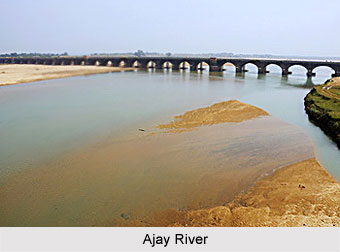 Ajay River is an important river which passes through the state of Jharkhand and West Bengal. The word "Ajay" means something that cannot be defeated or conquered.
Ajay River is an important river which passes through the state of Jharkhand and West Bengal. The word "Ajay" means something that cannot be defeated or conquered.
Geography of Ajay River
Ajay River originates on a small hill which is about 300 meters high, south west of Munger in the state of Bihar. Then it flows through Jharkhand and enters West Bengal at Simjuri, near Chittaranjan. This river also forms the border between Bardhaman District and Jharkhand and then between Birbhum District and Bardhaman District, and finally it enters Katwa subdivision of Bardhaman district at Nareng village in Ketugram police station. It then goes on to join the Bhagirathi River at Katwa Town. Total length of the Ajay is 288 km, out of which 152 km is in West Bengal. The catchment area of Ajay River is 6,000 km2.
Some of the significant tributaries of Ajay are Pathro and Jayanti in Jharkhand, and Tumuni and Kunur in Bardhaman district of West Bengal. The upper reach of the river pass through hilly regions with laterite soil. It is only from Ausgram in Bardhaman district that the Ajay flows through alluvial plains. The Ajay valley was densely forested with sal, piyasal and palas trees till recent times when mining and other activities led to the clearing of forests.
History of Ajay River
In many researches about the history of ancient India it has been found that the river called Amystis that flows past a town called Katadupa, in the days of Megasthenes. However, there is another historian Wilfred opines that Amystis is modern day Ajay. In the recent times there has been numerous investigation regarding the remains of ancient civilization similar to Indus Valley Civilization at Pandu Rajar Dhibi in the lower Ajay valley.
As per government records there have been 14 floods recorded in the 20th century in the Ajay River. In order to prevent flooding the lower reaches of the river have embankments.
Jaydev Kenduli, claimed to be the birth place of the 13th century Sanskrit poet Jayadeva of Geeta Govinda fame, and Churulia, birth place of Kazi Nazrul Islam are located on the banks of the Ajay.



















